If you’re considering a new puppy and a smaller breed suits your lifestyle, you may want to consider an adorable miniature schnauzer. Of course, there’s a lot to consider and learn when bringing home any new dog. In this article, we’ll be looking closely at what size miniature schnauzers grow to by creating a growth chart and listing milestones.
Read on to discover some of the essential facts you need to know when bringing home a miniature schnauzer.
Minature Schnauzer Summary
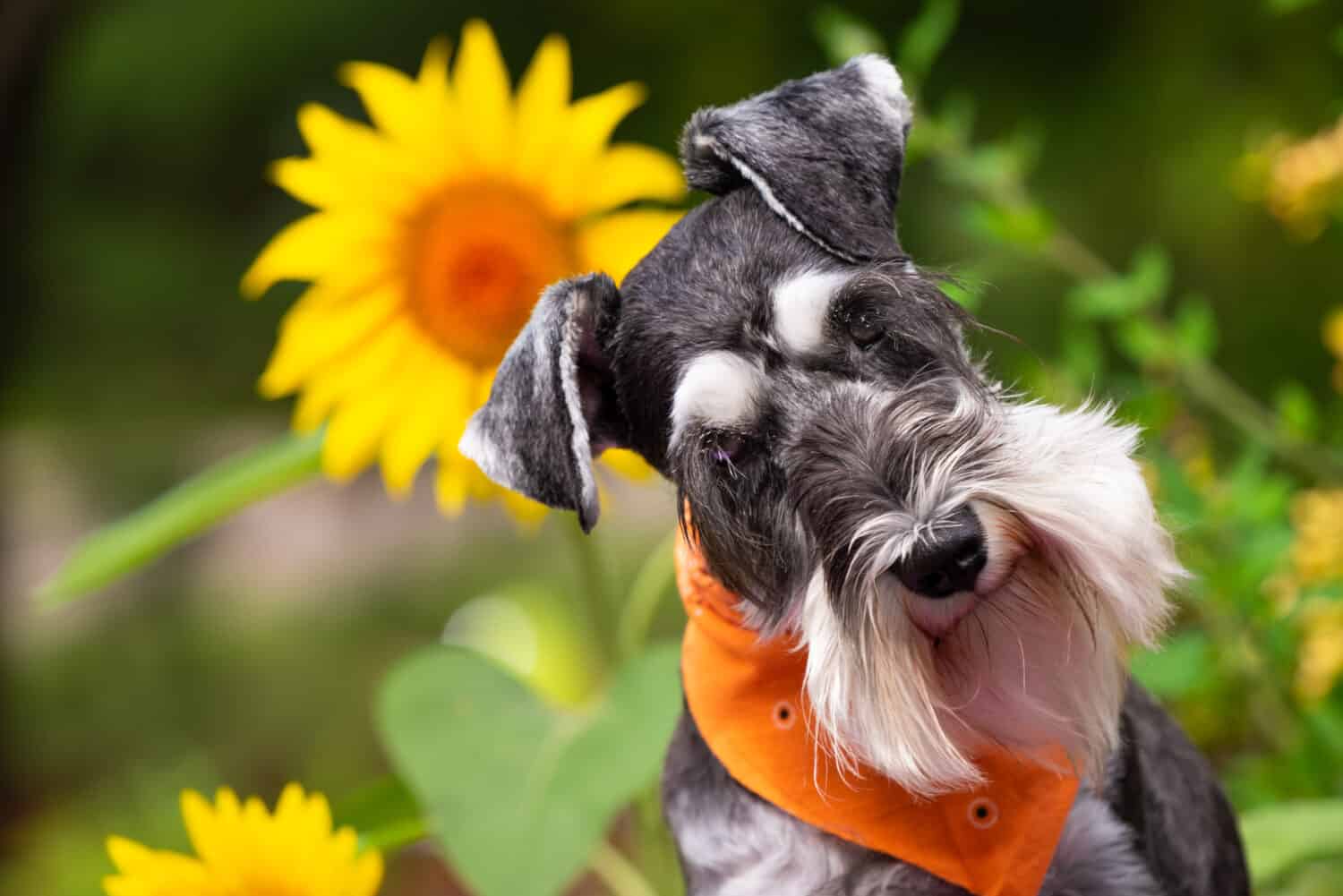
Miniature schnauzers, like their giant and standard kin, have the iconic mustache look.
©Debra Anderson/Shutterstock.com
Schnauzers come in three different sizes — giant, standard, and miniature. While the giant schnauzer weighs in at about 77 to as much as 95 pounds and grows to a height of about 36 inches, the standard schnauzer weighs between 30 and 50 pounds and stands at about 18 to 20 inches.
Miniature schnauzers are the smallest of the schnauzer breed. They grow to a height of about 12 to 14 inches and may weigh between 11 and 20 pounds. The mini schnauzer is affectionate and adaptable and makes a wonderful family companion.
The miniature schnauzer comes from the standard schnauzer, which dates back to the 15th century or before. German farmers bred their standard schnauzers to reach the miniature size we have today. The smaller size breed worked better as ratters because they could reach smaller places where rodents were hiding.
One of the unique characteristics of the miniature schnauzer is that it has no British heredity. While other terriers were developed and bred in the British Isles, the miniature schnauzer comes from German stock.
Miniature Schnauzer Growth and Weight Chart by Age
Listed below are the average weights of miniature schnauzers based on their age. The weight of each dog will also differ based on its individual characteristics and their gender. Moreover, females tend to be smaller than males.
| Age | Weight | Height |
|---|---|---|
| Birth | 4-9 ounces | 1-3 inches |
| 2 Weeks | 1-3 pounds | 4-5 inches |
| 2 Months | 2-5 pounds | 5-7 inches |
| 3 Months | 4-8 pounds | 6-8 inches |
| 4 Months | 7-11 pounds | 7-10 inches |
| 6 Months | 9.5-16 pounds | 9-11 inches |
| 8 Months | 10-18 pounds | 11-12 inches |
| 10 Months | 11-18 pounds | 11-13 inches |
| 12 Months | 11-18 pounds | 12-14 inches |
| 18 Months | 11-20 pounds | 12-14 inches |
When Will My Miniature Schnauzer Stop Growing?
A miniature schnauzer typically reaches its adult size by 12 months of age. Depending on genetics, exercise, and nutrition, this breed can gain additional weight — and less commonly height — after their first year of life. Additionally, males tend to be a bit taller and heavier than females.
This dog breed is prone to obesity, so it’s essential to maintain regular vet check-ups to ensure a healthy weight. It’s particularly crucial to keep your puppy up-to-date with regular vet check-ups and vaccinations in the first six months of its life, ideally every three to four weeks.
How Big Will My Miniature Schnauzer Be When It’s Fully Grown?
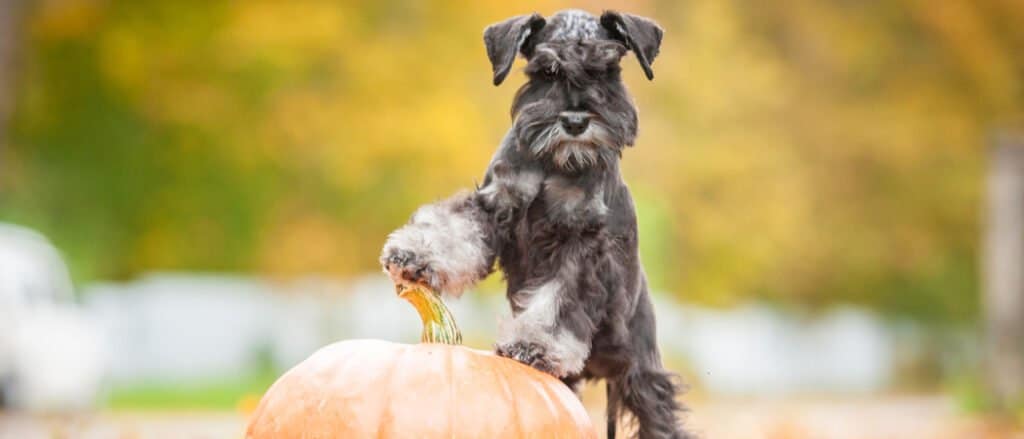
Miniature schnauzers typically reach a weight of between 11 and 20 pounds and a height of 11 to 13 inches, depending on many factors.
©Rita_Kochmarjova/Shutterstock.com
A fully grown male miniature schnauzer will usually weigh about 12 to 20 pounds and stand about 11-13 inches tall. A female, on the other hand, will typically weigh between 11 and 18 pounds and will also stand about 11 to 13 inches tall.
Naturally, sizes vary among individuals. The quality of dog food you feed your dog, the amount of exercise, and genetics all play a part in how big your miniature schnauzer will get. One good predictor of your dog’s adult size is the size of both parents.
The Biggest Miniature Schnauzer Ever Mentioned
Though there is no official record of this, a United Kingdom owner going by the name of PinkLemondades95 reports having a miniature schnauzer named Monty. She claims that her Monty is a little less than a year old and weighs 28 pounds. She claims that Monty has no fat on him and that he’s merely bigger than the average miniature schnauzer.
When Should My Miniature Schnauzer Be Spayed or Neutered?
Many veterinarians recommend spaying or neutering your schnauzer to prevent unwanted pregnancies. Although there are different opinions about the best time to neuter or spay your miniature schnauzer, many vets recommend desexing them at about six months.
When Should My Miniature Schnauzer Be House Broken?
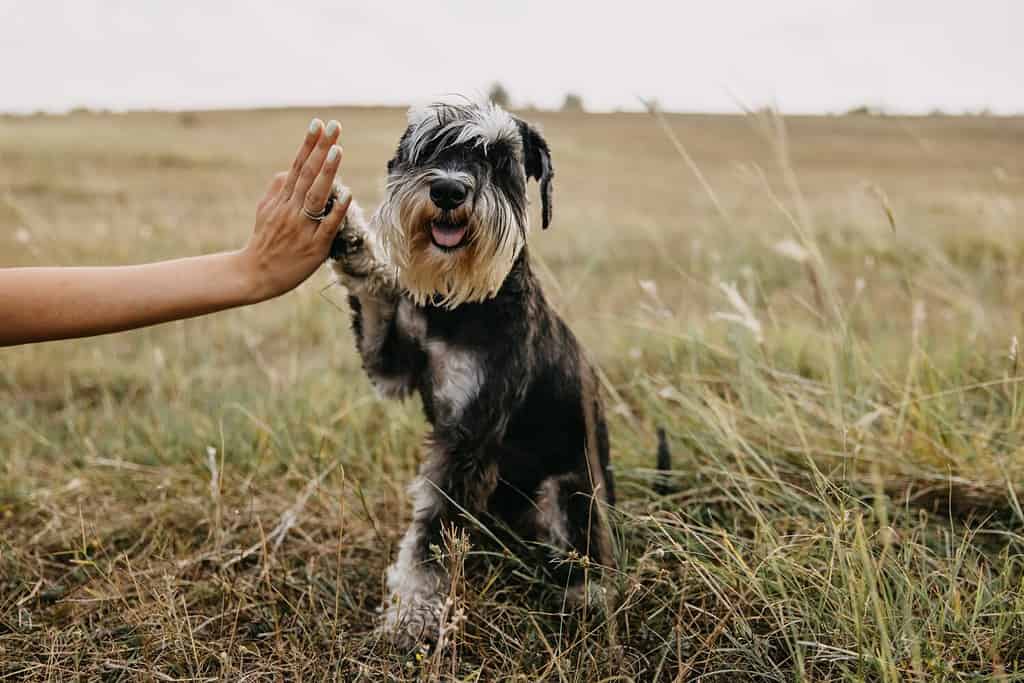
With patience, commitment, and consistency, you can housetrain your miniature schnauzer in a short time.
©Natalia Bostan/Shutterstock.com
Puppies typically leave their littermates and moms behind when they’re about eight weeks old. This is usually when you can bring your little bundle of fur into your home. It’s important to remember that this is an overwhelming time for your new puppy as they make the transition from their mothers to their new home with you.
Before beginning your housetraining, you may find it helpful to set up a consistent schedule and routine for meals, potty breaks, nap times, and bedtimes. In addition, giving your puppy lots of snuggles and attention will help to create a loving bond between the two of you. This will make training your pup easier for both of you.
One crucial precursor to housetraining is crate training your miniature schnauzer puppy. This should begin as soon as you introduce your puppy to their new home. Once your puppy feels comfortable in their crate, it will be much easier to house train them.
You can begin housetraining your puppy immediately. Begin by scheduling their meals and picking. up their dish about 15 minutes after they start eating whether they’re done eating or not. This establishes a good schedule for them. Then, take them out within 30 to 60 minutes after their meal on a leash.
Encourage them by urging them to “go potty,” and then wait for them to relieve themselves. Once they go to the bathroom, praise them and give them a treat. Housetraining a puppy takes consistency, patience, and commitment. However, with all of the appropriate pieces in place, your mini schnauzer will be well on their way to being trained in a short time.
When Should My Miniature Schnauzer Stop Eating Puppy Food?
Once your miniature schnauzer is weaned from their mother, they are ready for four meals a day of a vet-recommended highly nutritious puppy food. By the age of three months, you can feed them three times a day. At about five months old, you can decrease the feedings to twice a day.
By the time your puppy is 10 months old to one year old, you can switch to adult dog food. However, it’s always essential to check with your vet before taking your miniature schnauzer off of puppy food.
When Will My Miniature Schnauzer Start Losing Teeth?
Miniature Schnauzers usually begin losing their teeth when they reach four to six months old. When they’ve reached eight months old, most mini schnauzers have lost all of their baby teeth. Moreover, by the time they’re one year old, they typically have all of their adult teeth to replace the lost baby teeth.
Though mini schnauzers will have all their adult teeth by the time they’re two, and most by the time they’re one, you can start getting your puppy used to having their teeth brushed right away. Regular brushing and vet cleanings from the time they’re puppies will help ensure that your adult mini schnauzer will have healthy teeth for their whole lives.
When Should I Start Training My Miniature Schnauzer?

You can start training your miniature schnauzer right away.
©dien/Shutterstock.com
Your mini schnauzer puppy is able to begin learning simple commands as young as eight weeks old. However, puppies do have short attention spans, so it’s important to keep the training sessions short. It’s also essential that the sessions be positive and build success for your pup.
You can start socializing your puppy around other dogs and people right away. Doing so helps your dog become a more adaptable and confident dog. Housetraining, as mentioned earlier in this article, can begin right away as well.
Your puppy will respond well to praise, a calm but assertive tone, affection, and play. When you make the training fun, both you and your mini schnauzer will enjoy it.
What Commands Should I Teach My Miniature Schnauzer First?
This breed of dog is very intelligent, and they have a lot of energy. They also want to please you, so training them may be easier than training other breeds. With that said, there are some basic commands that you may want to focus on first to ensure your dog’s safety and ability to be around other people and animals.
- Sit is a natural concept for your dog, so it’s a good one to start off your training. It also serves as a transition command for other cues.
- Come will help you to get your dog back to safety if they break off their leash or escape from your yard.
- Stay is a command that helps you keep your puppy from running into the street or into other danger.
- Down (or lie down) gets your dog into a position that gives you more control and helps you keep them safe. It’s also a transition into other commands, such as playing dead or rolling over.
- No (or Leave it) keeps your dog safe by keeping them away from dangerous items that they might be interested in.
- Heel allows you to take your dog on a more pleasant walk with a loose leash. It also allows you to keep them close to your side and safe.
- Off can help you keep your dog off the furniture, from jumping up on people, or off of places they shouldn’t be.
When Will My Miniature Schnauzer Calm Down?
It’s important to remember that miniature schnauzers are highly energetic dogs. Puppies and young adults are even more energetic than their adult counterparts. However, these dogs reach maturity at one year of age, and that’s when they will typically start to settle down.
It’s critical to give your miniature plenty of exercise to expend their energy in a positive way. Training them with new commands and giving them brain puzzles will also help to keep them busy and non-destructive. If you give them lots of positive attention and keep them busy, that should combat most of their “hyperactiveness.”
Common Health Issues Your Miniature Schnauzer Might Experience
There has been a trend to “shrink” down many dog breeds to obtain a smaller or miniature breed. While miniature schnauzers aren’t a recent breed — in fact, they’ve been around since possibly the 15th century — they’re still more prone to certain health conditions than their standard and giant counterparts. The six most common issues are listed below.
- Pancreatitis – This condition of the pancreas could be caused by genetics, poor nutrition, obesity, diabetes, or blunt trauma. A change in diet and medications can help with this issue.
- Follicular dermatitis – This condition isn’t life-threatening, but it can be very uncomfortable for your pup. It’s caused by a bacteria that infects and irritates your dog’s hair follicles.
- Myotonia Congenita – This condition is congenital and can cause a dog’s muscles to stay contracted even after they rest from exercise. It can also cause a swollen tongue, balance issues, a stiff gait, or muscles that bulge and are difficult to move.
- Kidney Stones – As in humans, kidney stones can cause pain in your dog’s stomach, increased or decreased urination, blood in their urine, kidney pain, decreased appetite, vomiting, and lethargy.
- Hip dysplasia – This is more common in standard schnauzers. It’s a condition that affects your dog’s cartilage, causing degeneration and osteoarthritis, along with joint subluxation.
- Central hypothyroidism – This condition usually affects older dogs and can cause weight gain, lack of energy, skin problems, ear infections, and intolerance to the cold.
It’s important to take your miniature schnauzer for regular vet check-ups and keep an eye on any changes in physical appearance or behavior. A highly nutritious, vet-recommended diet along with regular exercise, access to clean water, and a nurturing, loving home will all help you maintain your dog’s good health and mental well-being.
Pictures of Miniature Schnauzers as Puppies
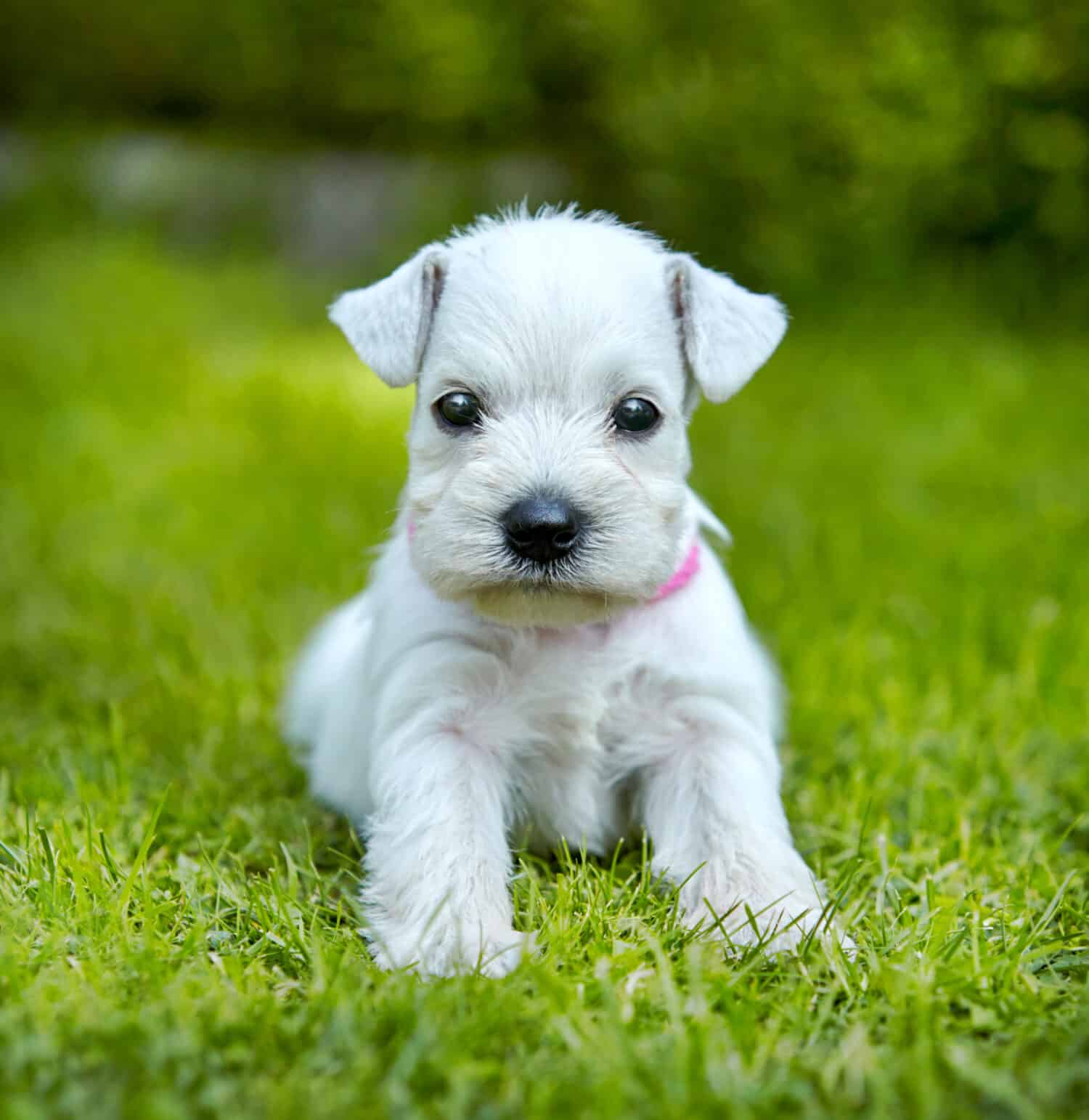
Mini schnauzers come in many
colors
— black, black and silver, salt and pepper, red, cream, liver and tan, black and red, liver pepper, chocolate, and white chocolate, along with parti colors.
©MaraZe/Shutterstock.com
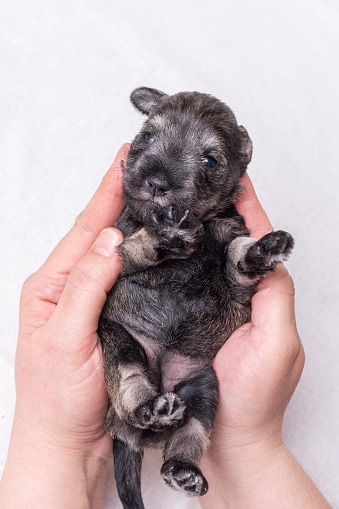
Newborn miniature schnauzers still can’t see until they’re 14 to 21 days old.
©Alena Ivochkina/iStock via Getty Images

These little furry balls of fun are irresistibly cute.
©Watch Inda/iStock via Getty Images
Pictures of Miniature Schnauzers at 6 Months

When training your puppy at 6 months of age, you’ll still want to keep sessions relatively short.
©Real Photo Maker/Shutterstock.com

Miniature schnauzer puppies are often spayed or neutered at the age of six months old.
©cynoclub/iStock via Getty Images
Pictures of Fully Grown Miniature Schnauzers
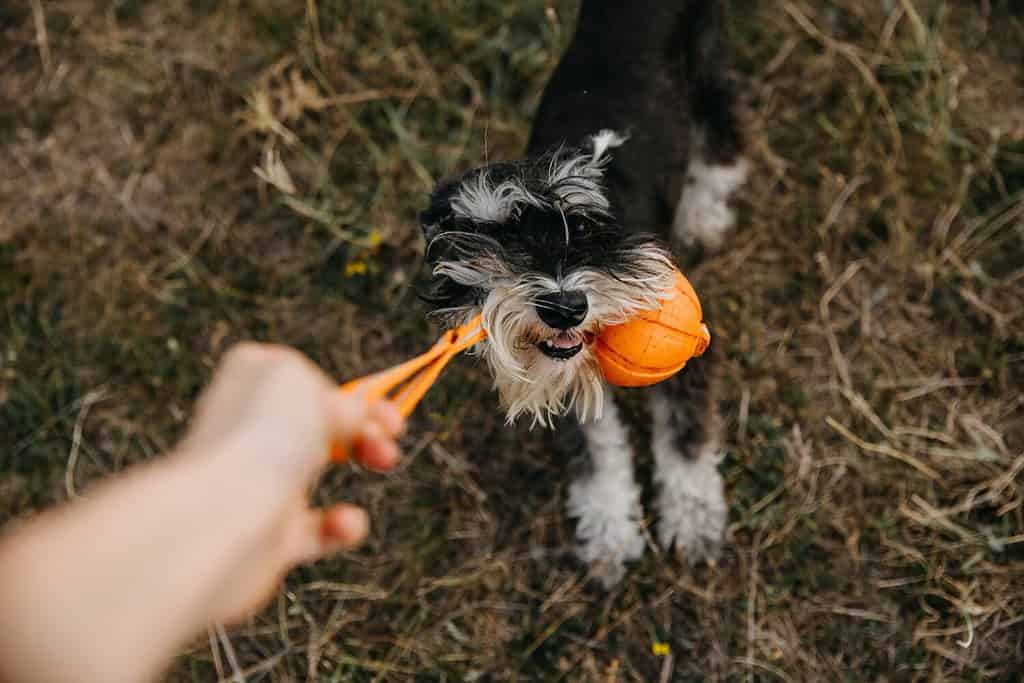
Miniature schnauzers are energetic and affectionate dogs.
©Natalia Bostan/Shutterstock.com
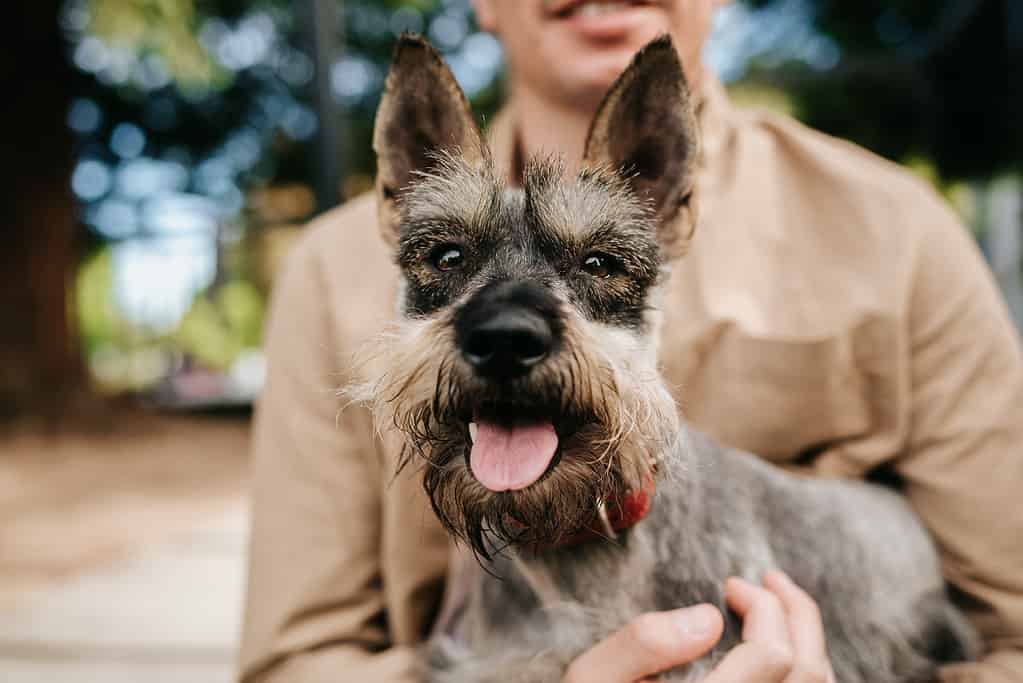
Miniature schnauzers usually reach maturity at one year of age.
©iStock.com/Wirestock
The photo featured at the top of this post is © Lunja/Shutterstock.com
Thank you for reading! Have some feedback for us? Contact the AZ Animals editorial team.






